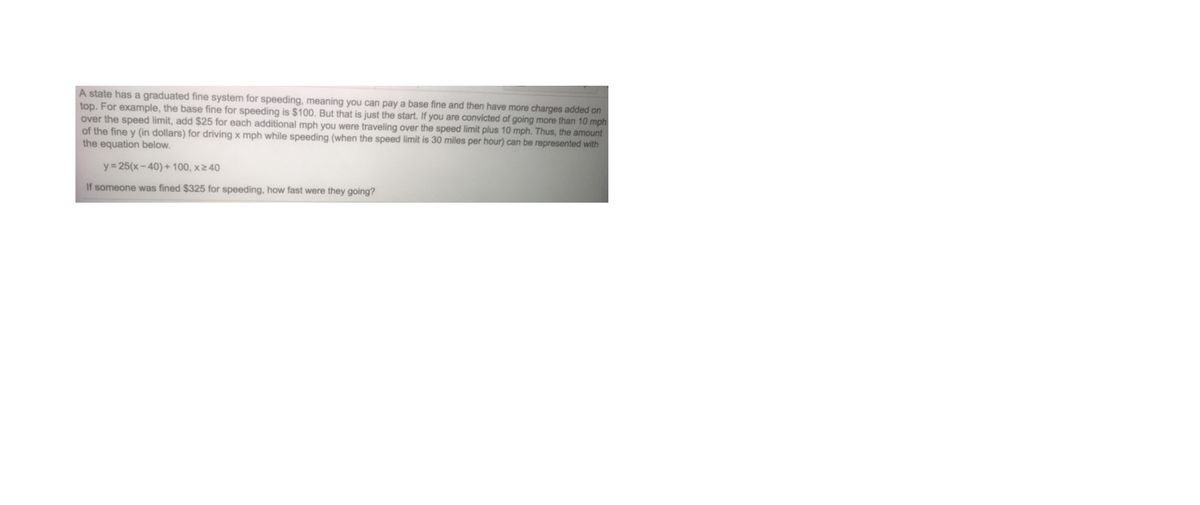A state has a graduated fine system for speeding, meaning you can pay a base fine and then have more charges added on top. For example, the base fine for speeding is $100. But that is just the start. If you are convicted of going more than 10 mph over the speed limit, add $25 for each additional mph you were traveling over the speed limit plus 10 mph. Thus, the amount of the fine y (in dollars) for driving x mph while speeding (when the speed limit is 30 miles per hour) can be represented with the equation below. y= 25(x– 40) + 100, x2 40 If someone was fined $325 for speeding, how fast were they going?
A state has a graduated fine system for speeding, meaning you can pay a base fine and then have more charges added on top. For example, the base fine for speeding is $100. But that is just the start. If you are convicted of going more than 10 mph over the speed limit, add $25 for each additional mph you were traveling over the speed limit plus 10 mph. Thus, the amount of the fine y (in dollars) for driving x mph while speeding (when the speed limit is 30 miles per hour) can be represented with the equation below. y= 25(x– 40) + 100, x2 40 If someone was fined $325 for speeding, how fast were they going?
Managerial Economics: A Problem Solving Approach
5th Edition
ISBN:9781337106665
Author:Luke M. Froeb, Brian T. McCann, Michael R. Ward, Mike Shor
Publisher:Luke M. Froeb, Brian T. McCann, Michael R. Ward, Mike Shor
Chapter20: The Problem Of Adverse Selection Moral Hazard
Section: Chapter Questions
Problem 3MC
Related questions
Question
Solve the attachment

Transcribed Image Text:A state has a graduated fine system for speeding, meaning you can pay a base fine and then have more charges added on
top. For example, the base fine for speeding is $100. But that is just the start. If you are convicted of going more than 10 mph
over the speed limit, add $25 for each additional mph you were traveling over the speed limit plus 10 mph. Thus, the amount
of the fine y (in dollars) for driving x mph while speeding (when the speed limit is 30 miles per hour) can be represented with
the equation below.
y= 25(x– 40) + 100, x2 40
If someone was fined $325 for speeding, how fast were they going?
Expert Solution
This question has been solved!
Explore an expertly crafted, step-by-step solution for a thorough understanding of key concepts.
This is a popular solution!
Trending now
This is a popular solution!
Step by step
Solved in 2 steps

Knowledge Booster
Learn more about
Need a deep-dive on the concept behind this application? Look no further. Learn more about this topic, economics and related others by exploring similar questions and additional content below.Recommended textbooks for you

Managerial Economics: A Problem Solving Approach
Economics
ISBN:
9781337106665
Author:
Luke M. Froeb, Brian T. McCann, Michael R. Ward, Mike Shor
Publisher:
Cengage Learning

Managerial Economics: A Problem Solving Approach
Economics
ISBN:
9781337106665
Author:
Luke M. Froeb, Brian T. McCann, Michael R. Ward, Mike Shor
Publisher:
Cengage Learning